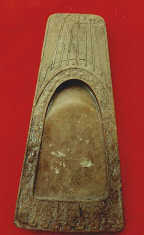Chinese calligraphyhas Four Treasures of Study -Wenfangsibao, orwriting brush, ink stick, ink slab, andpaper. These four traditional 'treasures' have played an important role in disseminating culture and art in China, and with the passing of time, ink stones have became art works themselves.
A look into the origin, selection of the raw materials, special varieties, and making of the famous ink slabs reveals the historical, cultural, and aesthetic values throughout Chinese history.
Ink slabs originated from the grinding implements used in primitive Chinese society to grind pigment on stone. There is a lot of archeological evidence to show that ancient Chinese used ink slabs for grinding ink. A stone ink slab was found in a 5,000-year-old archeological site in Jiazhai,Shanxi Province. In theHan Dynasty(206BC-220AD), ink slabs were widely used as writing utensils.
After many years of development, the craftsmanship of making ink slabs consummated in the Ming (1368-1644) and Qing (1644-1911) dynasties, with a lot of famous ink slabs produced. The Ming era ink slabs were made according to the original shapes of the stone, and various forms like lotus leaves, men's faces, crescents, ancient coins, and gourds were finely carved into the stone. By the Qing era, ink slabs more importance was attached to inscription and decoration, and ink slabs had become artistic works for collection rather than merely for practical use.
 |
 |
|
| Seven-star string instrument ink slab. | Duan ink slab with inscription of Mi Wanzhong in the Ming Dynasty. | Ink slab collected by Huang Shentian of the Qing Dynasty. On the back is his inscription. |
Most ink slabs are made of stone, while are made of porcelain,bronze,or lacquer. Three of the so-called Four Famous Chinese Ink Slabs are stone, and only one is porcelain.











